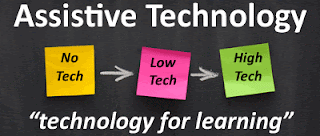Sunday, November 9, 2014
Blog Assignment #12
My family has a history of hearing impairment. My maternal grandfather wore hearing aids from his 40s on to his death at 89. My mother is very hard of hearing, as are most of her siblings. I have lost a significant amount of hearing in my right ear due to military service and I imagine my genetics don't help with that. I have often thought of what it would be like if I was afflicted with my family's impairment at a school age. This post was a great chance to see what would be available to me if I was a hearing impaired student today. The Hearing Loss Association of America has a section of its website dedicated to Hearing Assistive Technology. In the link they talk about an FM system. I have vivid memories of my grandfather using one of these to listen to the TV. After multiple complaints from my grandmother about him blasting Braves games at full volume they invested in one of these FM systems. He placed the receiver close to the speakers of the TV and he had it hooked into his hearing aids. As an educator, I can see this working well in the classroom. The teacher could simply wear the receiver around his or her neck, or keep it on the desk if it was powerful enough, and the student could take it from class to class. It seems kind of primitive in today's technological world, but if it isn't broke, don't fix it. I guess.
Linked here is a video from Oklahoma about Assistive Technologies that educators can use to help deaf/hearing impaired students. Around the 5:30 mark of the video, the iPad is discussed. It seems as though iPads are becoming quite the norm in classrooms these days. I found this short section of the video to be very interesting, as I'm expecting to have iPads available to me in my future classrooms. Here is a short video of deaf students using iPads for the first time. You can see how excited the children are, but also look and see how engaged they are in their learning. My wife, God bless her, is an avid Pinterest user and heard me talking about this blog post. She very quickly found this board. I don't really know how Pinterest works, but there is some really great information on that link. That's what's so great about our modern world today; there's so much information out there. I think that if we just put forth the effort, real effort, to find it, then we will always be in a position to help our students. -Kyle Parrish
Assistive technology can help students with learning disabilities leverage their education. It can be a wonderful tool for students that have Dysgraphia which affects a student's writing ability. This disability primarily affects handwriting and coherence. Students with this writing disorder will not perform efficiently when being taught how to form letters. Furthermore, they will probably forget how to correctly form words later because of improper movements of muscles required to write. However, there have been technologies created to help them counter this problem.
Dragon Dictation is a speech recognition application that produces words you speak by recording your voice. It allows you to update social media statuses such as facebook and twitter by speaking. Dragon allows you to speak and send emails or text messages. Additionally, people can create notes and reminders to help them navigate throughout the day. This technology could be useful for students in the classroom who have Dysgraphia because it would allow them to complete their writing assignments by speaking out their words. As a teacher I could allow a student to use their device to assist them in the writing process. This is another way technology is affecting education in a positive way because it is assisting students who have learning disabilities. -Justin Thomas
This short six minute YouTube video, Braille in the classroom, it helps you understand how braille works, how it is helpful, and some of the different types of braille. One of the devices they use is called braille display. This device will connect to the computer and will transfer the text from a computer screen into braille for the student. In the YouTube video iPad usage for the blind he shows us how to use the iPad from a blind person point of view. As he demonstrates, you can hear how he has the voice control instructing him in he background. The voice control helps him find his apps, tools, or whatever item he is looking for. Having an iPad in the classroom would be very beneficial to the student. Especially since everything is changing into technology. -Macy Roe
Math is a tough alone, and the hardest subject in school for some. I could only imagine how difficult it could be for a blind individual. In the video Teaching Math to the Blind Professor Art Karshmer introduces a tool that allows blind students to still use Braille, something they're familiar with, and electronic feedback. Instead of the math problem written in one horizontal line the student can align the math problem the way it should be. They are also able to receive verbal feedback of the math problem.
I think this tool is very useful for blind students. It is important for them to understand math because as Professor Art Karshmer said in order to get a job in engineering, technology, computer sciences etc. math is an important part of the equation, and the easier it is to practice and understand it the better, and with this tool its definitely possible. -Janae Ivory
Subscribe to:
Post Comments (Atom)

Great post! I also think that the video about teaching math to a blind student was interesting. Your links work great, and the source comes up on your picture!
ReplyDelete